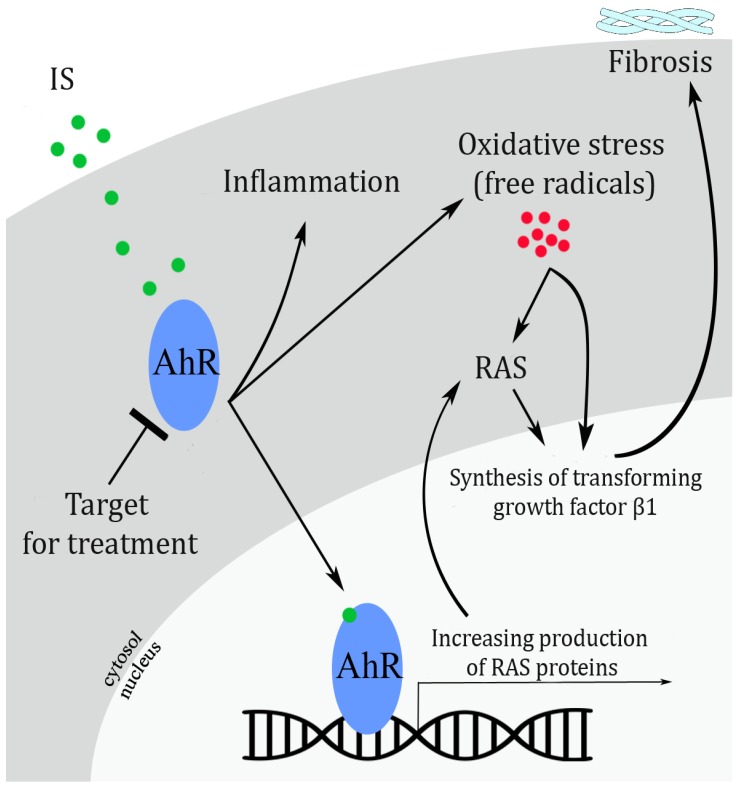Transl Clin Pharmacol.
2017 Sep;25(3):114-116. 10.12793/tcp.2017.25.3.114.
Inhibition of indoxyl sulfate-induced intrarenal renin-angiotensin system activation: targeting the aryl hydrocarbon receptor
- Affiliations
-
- 1Department of General Health Service, Sahabat Sehat Clinic, West Nusa Tenggara, Indonesia, Department of Medicine, University of Melbourne St. Vincent's Hospital Melbourne, Australia. mfakbar@connect.hku.hk
- KMID: 2390929
- DOI: http://doi.org/10.12793/tcp.2017.25.3.114
Abstract
- Indoxyl sulfate, a protein-bound uremic toxin, leads to CKD (chronic kidney disease) progression and its complications through the activation of AhR (aryl hydrocarbon receptor) and RAS (renin-angiotensin system). Inhibition of these pathways may slow the development of CKD and CKD-associated complications.
Keyword
MeSH Terms
Figure
Reference
-
1. Mills KT, Xu Y, Zhang W, Bundy JD, Chen CS, Kelly TN, et al. A systematic analysis of world-wide population-based data on the global burden of chronic kidney disease in 2010. Kidney Int. 2015; 88:950–957. DOI: 10.1038/ki.2015.230. PMID: 26221752.
Article2. Niwa T. Role of indoxyl sulfate in the progression of chronic kidney disease and cardiovascular disease: experimental and clinical effects of oral sorbent AST-120. Ther Apher Dial. 2011; 15:120–124. DOI: 10.1111/j.1744-9987.2010.00882.x. PMID: 21426500.
Article3. Sun CY, Chang SC, Wu MS. Uremic toxins induce kidney fibrosis by activating intrarenal renin–angiotensin–aldosterone system associated epithelial-to-mesenchymal transition. PLoS One. 2012; 7:e34026. DOI: 10.1371/journal.pone.0034026. PMID: 22479508.
Article4. Watanabe I, Tatebe J, Namba S, Koizumi M, Yamazaki J, Morita T. Activation of aryl hydrocarbon receptor mediates indoxyl sulfate-induced monocyte chemoattractant protein-1 expression in human umbilical vein endothelial cells. Circ J. 2013; 77:224–230. DOI: 10.1253/circj.CJ-12-0647. PMID: 23037589.
Article5. Siragy HM, Carey RM. Role of the intrarenal renin-angiotensin-aldosterone system in chronic kidney disease. Am J Nephrol. 2010; 31:541–550. DOI: 10.1159/000313363. PMID: 20484892.
Article6. Schroeder JC, DiNatale BC, Murray IA, Flaveny CA, Liu Q, Laurenzana EM, et al. The uremic toxin 3-indoxyl sulfate is a potent endogenous agonist for the human aryl hydrocarbon receptor. Biochemistry. 2010; 49:393–400. DOI: 10.1021/bi901786x. PMID: 20000589.
Article7. Zhang N, Agbor LN, Scott JA, Zalobowski T, Elased KM, Trujillo A, et al. An activated renin–angiotensin system maintains normal blood pressure in aryl hydrocarbon receptor heterozygous mice but not in null mice. Biochem Pharmacol. 2010; 80:197–204. DOI: 10.1016/j.bcp.2010.03.023. PMID: 20359465.
Article8. Ichii O, Otsuka-Kanazawa S, Nakamura T, Ueno M, Kon Y, Chen W, et al. Podocyte injury caused by indoxyl sulfate, a uremic toxin and aryl-hydrocarbon receptor ligand. PLoS One. 2014; 9:e108448. DOI: 10.1371/journal.pone.0108448. PMID: 25244654.
Article9. Ng HY, Yisireyili M, Saito S, Lee CT, Adelibieke Y, Nishijima F, et al. Indoxyl sulfate downregulates expression of Mas receptor via OAT3/AhR/Stat3 pathway in proximal tubular cells. PLoS One. 2014; 9:e91517. DOI: 10.1371/journal.pone.0091517. PMID: 24614509.
Article10. Lekawanvijit S, Kompa AR, Manabe M, Wang BH, Langham RG, Nishijima F, et al. Chronic kidney disease-induced cardiac fibrosis Is ameliorated by reducing circulating levels of a non-dialysable uremic toxin, indoxyl sulfate. PLoS One. 2012; 7:e41281. DOI: 10.1371/journal.pone.0041281. PMID: 22829936.
Article11. Ito S, Osaka M, Edamatsu T, Itoh Y, Yoshida M. Crucial Role of the Aryl Hydrocarbon Receptor (AhR) in Indoxyl Sulfate-Induced Vascular Inflammation. J Atheroscler Thromb. 2016; 23:960–975. DOI: 10.5551/jat.34462. PMID: 26860885.
Article12. Pernomian L, da Silva CHTP. Current basis for discovery and development of aryl hydrocarbon receptor antagonists for experimental and therapeutic use in atherosclerosis. Eur J Pharmacol. 2015; 764:118–123. DOI: 10.1016/j.ejphar.2015.06.058. PMID: 26142084.
Article
- Full Text Links
- Actions
-
Cited
- CITED
-
- Close
- Share
- Similar articles
-
- Effects of Cyclosporine on the Intrarenal Renin-Angiotensin System
- Recent Update of Renin-angiotensin-aldosterone System in the Pathogenesis of Hypertension
- Aryl Hydrocarbon Receptor Ligands Indoxyl 3-sulfate and Indole-3-carbinol Inhibit FMS-like Tyrosine Kinase 3 Ligand-induced Bone Marrow-derived plasmacytoid Dendritic Cell Differentiation
- Renin Angiotensin System in Rabbit Corpus Cavernosum: Functional Characterization of Angiotensin II Receptors
- Renal Interstitial Fibrosis and Renin Angiotensin System Inhibition


